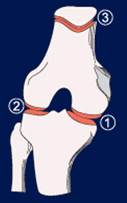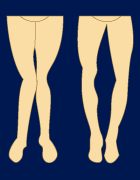Knee: General information on knee osteoarthritis
Knee osteoarthritis or gonarthrosis ("gon" signifying knee) is the most common location of osteoarthritis. According to an American study, knee osteoarthritis affects 0.24% of people a year, with a significantly higher incidence above the age of 70 to 80 years. (1% of women 0.8% of men).
The knee is a hinge joint consisting of three compartments: the patellofemoral joint (3), medial femorotibial compartment (1) and lateral femorotibial compartment (2).
Thus osteoarthritis can affect different areas of the knee:

- Internal femorotibial osteoarthritis (1),
- External femorotibial osteoarthritis (2),
- Patellofemoral osteoarthritis (3).
A distinction must be made between the primitive and secondary forms.
Primitive osteoarthritis is known as primitive as there are no obvious causes.
Osteoarthritis is known as secondary when its origin or cause can be identified. It is most often due to being overweight, an anomaly of the axis of the lower limbs (genu varum or genu valgum), the after-effects of a fracture or osteonecrosis, a history of meniscectomy or cruciate ligament rupture.









